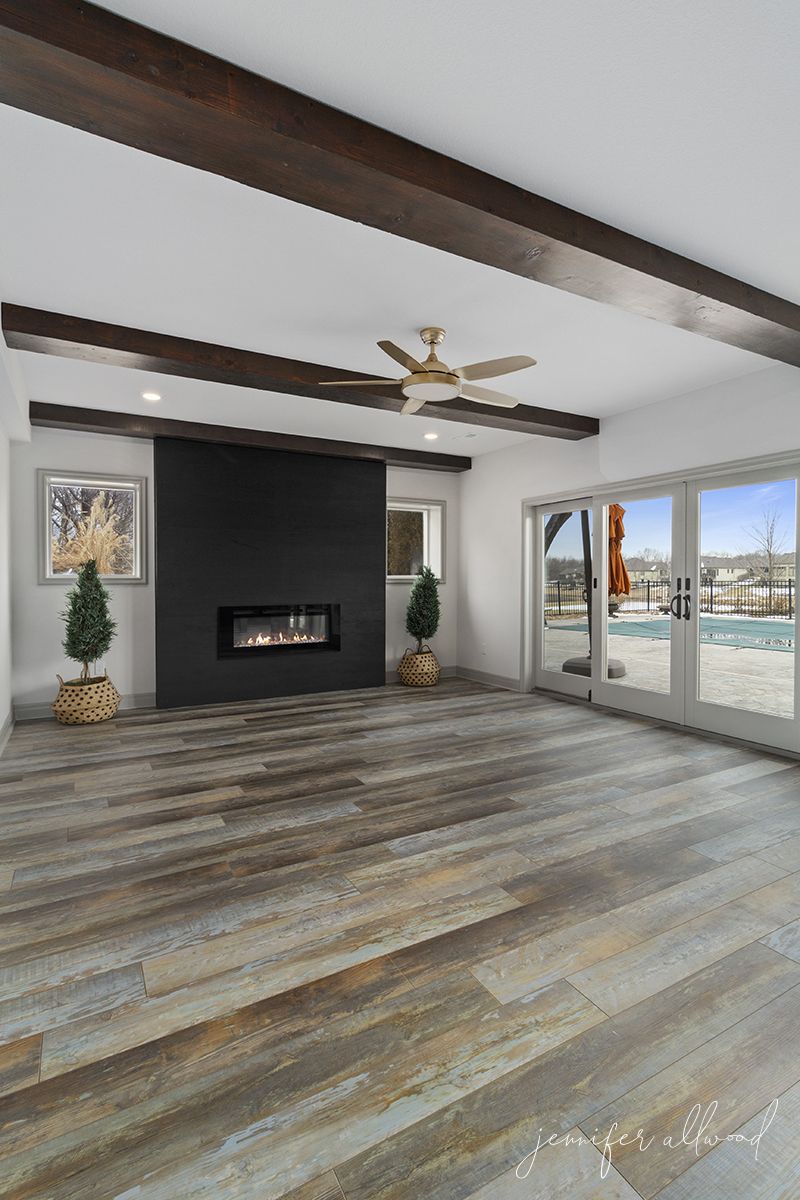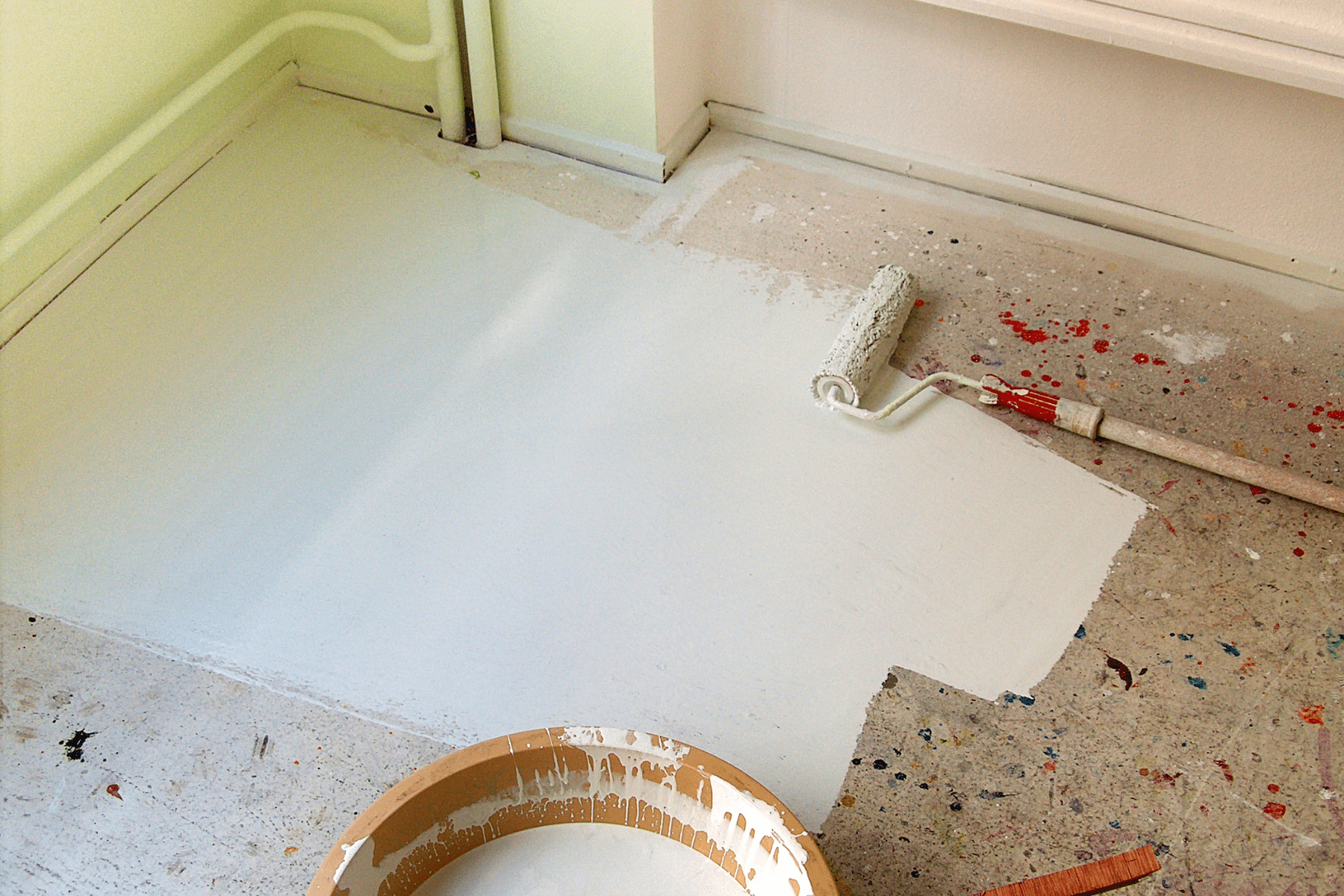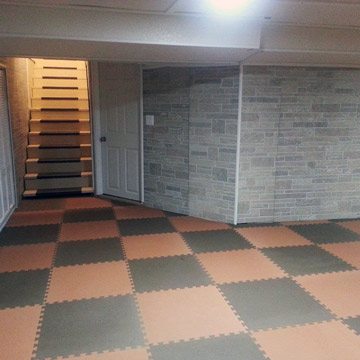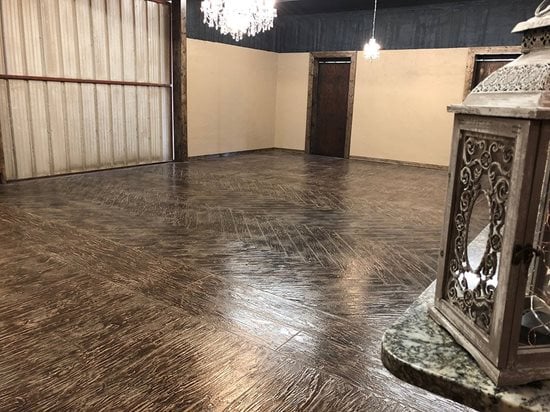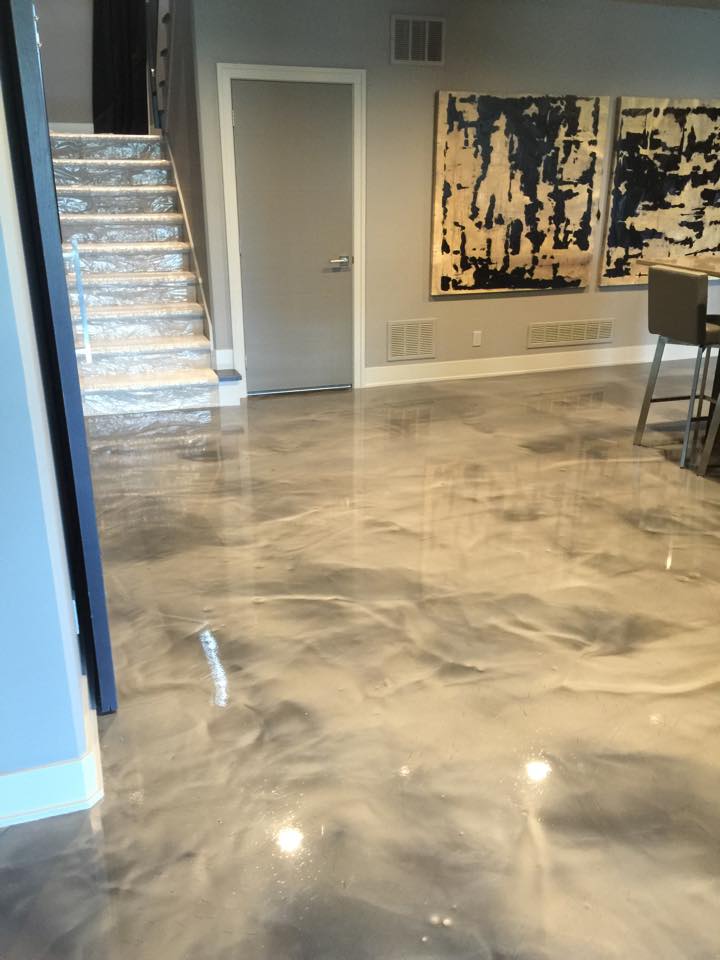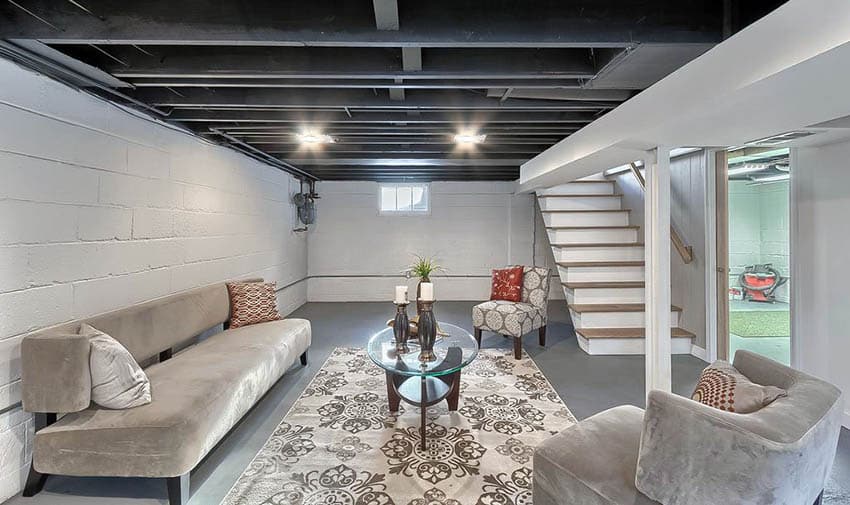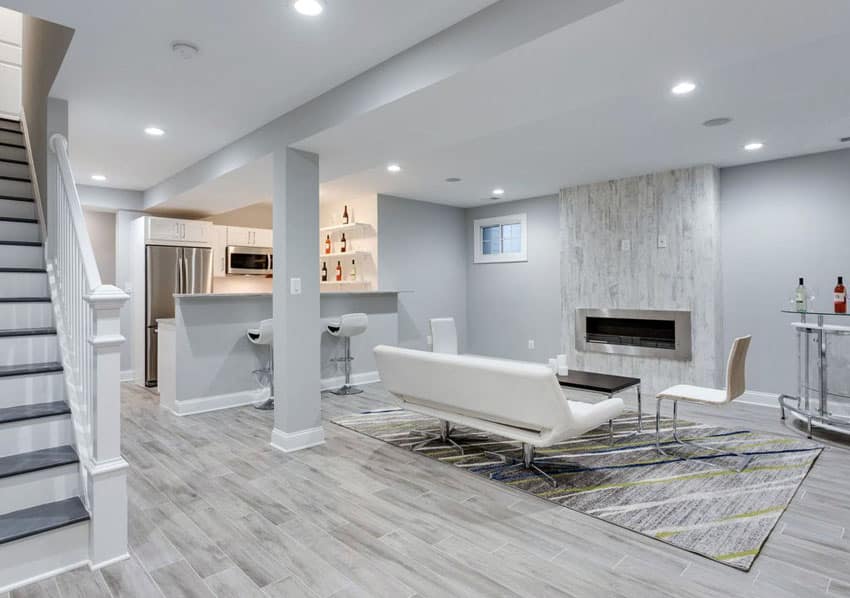Basements present unique flooring challenges due to moisture, temperature fluctuations, and below-grade conditions. Concrete flooring offers a practical and stylish solution, combining durability with modern design potential. Unlike traditional flooring materials that can warp or mold, properly treated concrete withstands humidity while providing a solid foundation. Homeowners can choose from several concrete-based options, including polished concrete, epoxy coatings, acid-stained finishes, and decorative overlays. Each method delivers distinct aesthetic and functional benefits, from industrial-chic polished surfaces to colorful, patterned epoxy designs. Beyond durability, concrete flooring improves thermal mass, helping regulate basement temperatures naturally. Whether you prefer a sleek, minimalist look or a creative, customized finish, concrete provides versatile solutions for transforming basement spaces into functional, attractive living areas.
Polished Concrete for a Modern Industrial Look
Polished concrete creates a sleek, high-end finish perfect for contemporary basement designs. The process involves grinding the concrete surface with diamond abrasives to achieve a smooth, glossy appearance. This method enhances the natural variations in the concrete, resulting in a unique, marble-like effect. Polished floors reflect light well, brightening typically dark basement spaces. They’re also extremely durable, resisting scratches, stains, and heavy foot traffic with minimal maintenance required.
The polishing process can be adjusted to different sheen levels, from matte to high-gloss, depending on preference. Adding color to the concrete mix before polishing creates customized hues that complement your basement’s decor. For added safety, non-slip additives can be incorporated into the final sealant. Unlike other flooring options, polished concrete doesn’t require adhesives or underlayments, making it ideal for below-grade installations where moisture resistance is crucial.
While polished concrete works well in finished basements, proper subfloor preparation is essential. The existing slab must be in good condition, without significant cracks or moisture issues. Professional installation ensures proper leveling and sealing to prevent future problems. Though the upfront cost may be higher than basic concrete finishes, the long-term durability and timeless appeal make polished concrete a worthwhile investment for homeowners seeking a low-maintenance, high-style flooring solution.
Epoxy Coatings for Color and Durability
Epoxy coatings transform plain concrete into vibrant, resilient flooring perfect for active basement spaces. These thick, plastic-like coatings bond chemically with the concrete, creating a seamless, non-porous surface. Available in countless colors and patterns, epoxy allows for creative designs like metallic swirls, flecked finishes, or even faux tile looks. The glossy surface resists moisture, chemicals, and stains, making it ideal for basements used as workshops, gyms, or entertainment areas.
Two-part epoxy systems provide the most durable results, with some formulations including decorative chips or quartz granules for texture. The installation process involves thorough cleaning, etching the concrete, and applying primer before the epoxy layers. Proper ventilation is crucial during application due to strong fumes. Once cured, epoxy forms an incredibly tough surface that withstands heavy furniture, dropped tools, and frequent cleaning without showing wear.
Maintenance is simple—just occasional mopping with mild cleaners preserves the shine. While DIY epoxy kits exist, professional application ensures proper adhesion and longevity, especially in basements with moisture concerns. Epoxy’s reflective quality helps brighten spaces, and its seamless nature prevents mold growth in the joints where moisture typically collects. For homeowners wanting colorful, personalized flooring that stands up to heavy use, epoxy-coated concrete delivers outstanding performance.

Acid-Stained Concrete for Organic Beauty
Acid staining creates one-of-a-kind, variegated finishes that enhance concrete’s natural character. The chemical reaction between acidic stains and concrete minerals produces rich, translucent color with marble-like veining. Earth tones like amber, terra cotta, and deep brown work particularly well, though modern stains offer blues and greens too. Each stained floor is unique, with organic patterns that can’t be replicated exactly, adding artistic flair to basement spaces.
The staining process involves cleaning the concrete, applying the acid solution, neutralizing the chemical reaction, and sealing the surface. Proper preparation ensures the stain penetrates evenly, while skilled application techniques create artistic effects like mottling or layered colors. A high-quality sealer protects the stained surface while enhancing color depth. Unlike paint or coatings, acid stain becomes part of the concrete rather than sitting on top, so it won’t peel or chip over time.
Stained concrete works especially well in basements with rustic, Mediterranean, or contemporary decor styles. The finish hides minor imperfections well and develops a lovely patina with age. While not as glossy as epoxy, stained concrete provides subtle sophistication with excellent durability. It’s also more slip-resistant than polished concrete when properly sealed. For homeowners seeking natural-looking flooring with artistic appeal, acid-stained concrete offers timeless beauty that improves with age.
Concrete Overlays for Custom Textures
Concrete overlays provide an excellent solution for worn or uneven basement slabs while offering design flexibility. These thin cement-based coatings (typically 1/8″ to 1/4″ thick) bond to existing concrete, creating a fresh surface for staining, stamping, or polishing. Overlays can mimic expensive materials like stone, brick, or wood plank flooring at a fraction of the cost. They’re particularly useful for covering cracked or discolored concrete without full replacement.
Microtoppings represent the thinnest overlay option, perfect for creating smooth, modern surfaces ideal for contemporary basements. Thicker overlays accommodate stamped patterns like cobblestone or herringbone designs. Some products incorporate polymer modifiers for increased flexibility and crack resistance—important features in below-grade applications. Skilled installers can create realistic grout lines, texture variations, and even 3D effects using specialized tools and techniques.
Proper surface preparation ensures overlay adhesion, often involving grinding, patching, and primer application. While overlays are more affordable than replacing concrete, professional installation maximizes durability. The finished surface can be sealed for moisture protection or left breathable in drier basements. Overlays offer homeowners the chance to completely transform their basement floors with customized colors, patterns, and textures while maintaining concrete’s inherent durability and thermal benefits.
Stained and Polished Combo Finishes
Combining staining and polishing techniques creates floors with both rich color and refined sheen. This hybrid approach begins with acid or water-based staining to establish deep, variegated hues. Subsequent polishing gradually reveals aggregate while developing a luxurious luster. The result showcases vibrant color with dimensional depth unattainable through either process alone. These floors work beautifully in basements serving as upscale living spaces, wine cellars, or home offices.
The multi-step process allows for creative control over the final appearance. Light polishing preserves more stain color for dramatic effects, while heavy polishing creates a terrazzo-like look with exposed aggregate. Metallic pigments can be added between steps for extra visual interest. The sealed finish resists wear while maintaining easy cleanability—just occasional damp mopping keeps the surface looking pristine. Unlike some floorings that show wear patterns over time, these combo finishes actually improve aesthetically as subtle texture variations become more apparent.
While DIY attempts are possible, professional installation ensures proper chemical handling and equipment use. The multi-day process requires precise timing between stages for optimal results. Though more labor-intensive than simple staining or polishing, the combined technique produces truly custom floors that elevate basement spaces from utilitarian to extraordinary. Homeowners appreciate how the depth of color changes with lighting conditions and viewing angles, creating dynamic visual interest.
Maintenance and Protection Strategies
Proper care preserves concrete flooring’s beauty and functionality for decades. Sealing is the most critical maintenance step, with options ranging from matte penetrating sealers to high-gloss coatings. Penetrating sealers protect against moisture and stains while maintaining a natural look, ideal for stained or polished floors. Film-forming sealers provide maximum protection for high-traffic areas but may require occasional recoating. Most sealers need reapplication every 2-5 years depending on use.
Regular cleaning involves sweeping to remove abrasive grit and mopping with pH-neutral cleaners. Avoid vinegar or ammonia-based products that can degrade sealers over time. Place felt pads under furniture legs to prevent scratches, and use area rugs in high-traffic zones to minimize wear. While concrete resists most stains, wipe up spills promptly, especially with acidic substances like wine or citrus juices that could etch the surface if left unattended.
In colder climates, consider radiant heating systems beneath concrete floors for added comfort. The thermal mass of concrete stores and evenly releases heat, improving energy efficiency. For basements prone to moisture, install a quality dehumidifier to maintain optimal humidity levels. Address any cracks or chips immediately to prevent water infiltration and further damage. With simple, consistent care, concrete basement flooring remains an attractive, high-performing surface that outlasts most conventional flooring options.
Concrete Floor Covering Options
Ideas for Your New Concrete Finished Basement
Basement Flooring Ideas (Best Design Options) – Designing Idea
Basement Flooring Ideas (Best Design Options) – Designing Idea
Basement Flooring Ideas – Love Home Designs
Best Concrete Floor Ideas – Smooth Flooring Interior Designs
Basement Flooring Ideas
Related Posts:
.jpg?widthu003d800u0026nameu003d11513489635_f12521f2a2_k%20(1).jpg)
